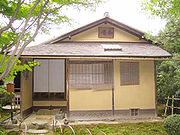
Jo-an (teahouse)
Encyclopedia

Chashitsu
In Japanese tradition, architectural spaces designed to be used for tea ceremony gatherings are known as chashitsu ....
in Inuyama, Aichi Prefecture
Aichi Prefecture
is a prefecture of Japan located in the Chūbu region. The region of Aichi is also known as the Tōkai region. The capital is Nagoya. It is the focus of the Chūkyō Metropolitan Area.- History :...
, Japan
Japan
Japan is an island nation in East Asia. Located in the Pacific Ocean, it lies to the east of the Sea of Japan, China, North Korea, South Korea and Russia, stretching from the Sea of Okhotsk in the north to the East China Sea and Taiwan in the south...
. Said to be one of the three finest teahouses in the country, in 1951 it was designated a National Treasure
National treasures of Japan
National Treasures are the most precious of Japan's Tangible Cultural Properties, as determined and designated by the Agency for Cultural Affairs...
.
History
Jo-an was originally built c.1618 in Kennin-jiKennin-ji
, is a historic Zen Buddhist temple in Higashiyama, Kyoto, Japan, near Gion. It is considered to be one of the so-called Kyoto Gozan or "five most important Zen temples of Kyoto".-History:...
, Kyoto
Kyoto
is a city in the central part of the island of Honshū, Japan. It has a population close to 1.5 million. Formerly the imperial capital of Japan, it is now the capital of Kyoto Prefecture, as well as a major part of the Osaka-Kobe-Kyoto metropolitan area.-History:...
by Oda Urakusai, younger brother of Oda Nobunaga
Oda Nobunaga
was the initiator of the unification of Japan under the shogunate in the late 16th century, which ruled Japan until the Meiji Restoration in 1868. He was also a major daimyo during the Sengoku period of Japanese history. His opus was continued, completed and finalized by his successors Toyotomi...
and disciple of Sen no Rikyū
Sen no Rikyu
, is considered the historical figure with the most profound influence on chanoyu, the Japanese "Way of Tea", particularly the tradition of wabi-cha...
. Relocated a number of times, since 1972 it has formed part of the Urakuen gardens in Inuyama.
Teahouse
Approached throughout the rojiRoji
, lit. 'dewy ground', is the Japanese term used for the garden through which one passes to the chashitsu for the tea ceremony. The roji generally cultivates an air of simplicity.-Development:...
or 'dewy ground' garden, the chashitsu
Chashitsu
In Japanese tradition, architectural spaces designed to be used for tea ceremony gatherings are known as chashitsu ....
or tea room measures two-and-a-half mats
Tatami
A is a type of mat used as a flooring material in traditional Japanese-style rooms. Traditionally made of rice straw to form the core , with a covering of woven soft rush straw, tatami are made in standard sizes, with the length exactly twice the width...
and has a three mat mizuya
Mizuya
Mizuya is the term for the preparation area in a Japanese tea house or attached to any venue used for the Japanese tea ceremony. For instance, the area used for preparation during outdoor tea ceremonies is also called the mizuya...
or preparation area. The building has a shake
Shake (shingle)
A shake is a basic wooden shingle that is made from split logs. Shakes have traditionally been used for roofing and siding applications around the world. Higher grade shakes are typically used for roofing purposes, while the lower grades are used for siding purposes...
roof and a nijiriguchi or 'crawling-in entrance'.
See also
- ChashitsuChashitsuIn Japanese tradition, architectural spaces designed to be used for tea ceremony gatherings are known as chashitsu ....
- Japanese tea ceremonyJapanese tea ceremonyThe Japanese tea ceremony, also called the Way of Tea, is a Japanese cultural activity involving the ceremonial preparation and presentation of matcha, powdered green tea. In Japanese, it is called . The manner in which it is performed, or the art of its performance, is called...
- List of National Treasures of Japan (residences)

